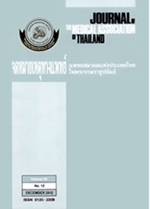Denollet’s Distressed Personality Trait (Type D)
อุทิศ แด่ ศ.ดร. โจฮัน โดเนลเล็ต แห่ง มหาวิทยาทิลเบอร์ก ประเทศเนเธอร์แลนด์ ผู้ได้สร้างคุณูปการแก่วงการจิตวิทยาและจิตเวชศาสตร์ ซึ่งได้จากไปในเดือน ตุลาคม ๒๕๖๒
Dedicated to Prof. Dr. Johan Donellet of Tilburg University, The Netherlands who has made contributions to the field of psychology and psychiatry. Prof.Dr. passed away in October 2019.
In Memoriam Johan Denollet (1957-2019) | Tilburg University

DS14
Prof.Dr. Donellet created the DS14 to measure the distressed type of personality trait. It has been tested in numerous populations and translated into many languages. We were gratefully granted the permission to translate the DS14(+3) into Thai version by Prof.Dr. Denollet in June 2012. We are highly appreciated and congratulate Prof. Dr. Denollet on what he has been accomplished and dedicated to people in this world.
เราได้อุทิศบุญกุศลที่ได้ทำมาตังแต่อดีต นับภพชาติไม่ถ้วน แด่ Prof. Denollet ขอผลบุญทั้งหลาย นำท่านไปสู่สัมปรายภพ ที่ที่มีแต่ความสุข สืบไป : ศ.นพ. ทินกร - ศ.พญ. ณหทัย วงศ์ปการันย์
Description:
The DS14 is a brief, psychometrically sound measure of negative affectivity and social inhibition that could readily be incorporated in epidemiologic and clinical research.
Measurement:
Thai Version of Type D personality trait (DS14+3)
Type D Thai.pdf
Scoring:
DS17
Negative Affectivity =DS2 + DS4 + DS5 + DS7 + DS9 + DS12 + DS13 + DS16
Social Inhibition=DS1(Reversed) + DS3(Reversed) + DS6 + DS8 + DS10 + DS11 + DS14 + DS15 + DS17
DS14 (no item 15-16-17)
Negative Affectivity =DS2 + DS4 + DS5 + DS7 + DS9 + DS12 + DS13
Social Inhibition=DS1(Reversed) + DS3(Reversed) + DS6 + DS8 + DS10 + DS11 + DS14

Psychometric property of Thai DS
DS17 has been tested in 1600 participants.
Reliability
Reliability Analysis
| Scale Reliability Statistics |
| |
Cronbach's α |
McDonald's ω |
| scale |
|
0.897 |
|
0.902 |
|
| Note. item 'ds3' correlates negatively with the total scale and probably should be reversed |
| |
Factor analysis results of Thai version DS17
|
KMO and Bartlett's Test
|
|
Kaiser-Meyer-Olkin Measure of Sampling Adequacy.
|
.923
|
|
Bartlett's Test of Sphericity
|
Approx. Chi-Square
|
13432.625
|
|
df
|
136
|
|
Sig.
|
.000
|
|
Communalities
|
|
|
Initial
|
Extraction
|
|
reversed
|
1.000
|
.678
|
|
ds2
|
1.000
|
.532
|
|
reversed
|
1.000
|
.614
|
|
ds4
|
1.000
|
.688
|
|
ds5
|
1.000
|
.728
|
|
ds6
|
1.000
|
.378
|
|
ds7
|
1.000
|
.584
|
|
ds8
|
1.000
|
.583
|
|
ds9
|
1.000
|
.665
|
|
ds10
|
1.000
|
.611
|
|
ds11
|
1.000
|
.594
|
|
ds12
|
1.000
|
.575
|
|
ds13
|
1.000
|
.674
|
|
ds14
|
1.000
|
.594
|
|
ds15
|
1.000
|
.580
|
|
ds16
|
1.000
|
.580
|
|
ds17
|
1.000
|
.603
|
|
Extraction Method: Principal Component Analysis.
|
|
Total Variance Explained
|
|
Component
|
Initial Eigenvalues
|
Extraction Sums of Squared Loadings
|
Rotation Sums of Squared Loadings
|
|
Total
|
% of Variance
|
Cumulative %
|
Total
|
% of Variance
|
Cumulative %
|
Total
|
% of Variance
|
Cumulative %
|
|
1
|
6.975
|
41.030
|
41.030
|
6.975
|
41.030
|
41.030
|
4.470
|
26.294
|
26.294
|
|
2
|
1.949
|
11.464
|
52.494
|
1.949
|
11.464
|
52.494
|
4.267
|
25.101
|
51.396
|
|
3
|
1.336
|
7.859
|
60.352
|
1.336
|
7.859
|
60.352
|
1.523
|
8.957
|
60.352
|
|
4
|
.853
|
5.020
|
65.372
|
|
|
|
|
|
|
|
5
|
.759
|
4.467
|
69.839
|
|
|
|
|
|
|
|
6
|
.657
|
3.862
|
73.702
|
|
|
|
|
|
|
|
7
|
.584
|
3.438
|
77.139
|
|
|
|
|
|
|
|
8
|
.555
|
3.266
|
80.406
|
|
|
|
|
|
|
|
9
|
.533
|
3.136
|
83.542
|
|
|
|
|
|
|
|
10
|
.468
|
2.751
|
86.293
|
|
|
|
|
|
|
|
11
|
.426
|
2.508
|
88.801
|
|
|
|
|
|
|
|
12
|
.400
|
2.354
|
91.155
|
|
|
|
|
|
|
|
13
|
.381
|
2.240
|
93.394
|
|
|
|
|
|
|
|
14
|
.334
|
1.965
|
95.360
|
|
|
|
|
|
|
|
15
|
.308
|
1.813
|
97.172
|
|
|
|
|
|
|
|
16
|
.251
|
1.475
|
98.647
|
|
|
|
|
|
|
|
17
|
.230
|
1.353
|
100.000
|
|
|
|
|
|
|
|
Extraction Method: Principal Component Analysis.
|
|
Component Matrixa
|
|
|
Component
|
|
1
|
2
|
3
|
|
reversed
|
.179
|
.467
|
.654
|
|
ds2
|
.588
|
-.431
|
|
|
reversed
|
|
.552
|
.556
|
|
ds4
|
.757
|
-.294
|
.170
|
|
ds5
|
.709
|
-.433
|
.196
|
|
ds6
|
.435
|
|
-.430
|
|
ds7
|
.711
|
-.215
|
.177
|
|
ds8
|
.693
|
.322
|
|
|
ds9
|
.686
|
-.382
|
.220
|
|
ds10
|
.736
|
.237
|
-.114
|
|
ds11
|
.677
|
.300
|
-.215
|
|
ds12
|
.749
|
-.117
|
|
|
ds13
|
.760
|
-.255
|
.180
|
|
ds14
|
.686
|
.332
|
-.112
|
|
ds15
|
.553
|
.372
|
-.369
|
|
ds16
|
.736
|
.194
|
|
|
ds17
|
.648
|
.396
|
-.162
|
|
Extraction Method: Principal Component Analysis.
|
|
a. 3 components extracted.
|
|
Rotated Component Matrixa
|
|
|
Component
|
|
1
|
2
|
3
|
|
reversed
|
|
.134
|
.807
|
|
ds2
|
.690
|
.139
|
-.191
|
|
reversed
|
-.138
|
|
.766
|
|
ds4
|
.780
|
.281
|
|
|
ds5
|
.837
|
.155
|
|
|
ds6
|
.195
|
.439
|
-.384
|
|
ds7
|
.703
|
.294
|
|
|
ds8
|
.310
|
.669
|
.199
|
|
ds9
|
.800
|
.160
|
|
|
ds10
|
.348
|
.698
|
|
|
ds11
|
.232
|
.735
|
|
|
ds12
|
.599
|
.460
|
|
|
ds13
|
.763
|
.303
|
|
|
ds14
|
.257
|
.719
|
.106
|
|
ds15
|
|
.755
|
|
|
ds16
|
.419
|
.622
|
.134
|
|
ds17
|
.173
|
.750
|
|
|
Extraction Method: Principal Component Analysis.
Rotation Method: Varimax with Kaiser Normalization.
|
|
a. Rotation converged in 5 iterations.
|
Velicer's Minimum Average Partial (MAP) Test:
Eigenvalues
4.6729
1.7710
.4810
.4214
.2332
.1867
.1373
.0965
Average Partial Correlations
squared power4
.0000 .3125 .1551
1.0000 .2451 .0736
2.0000 .0664 .0119
3.0000 .1276 .0519
4.0000 .2042 .1160
5.0000 .2718 .1526
6.0000 .4346 .3312
7.0000 1.0000 1.0000
The smallest average squared partial correlation is
.0664
The smallest average 4rth power partial correlation is .0119
The Number of Components According to the Original (1976) MAP Test is 2
The Number of Components According to the Revised (2000) MAP Test is 2
PARALLEL ANALYSIS:
Principal Components & Random Normal Data Generation
Specifications for this Run:
Ncases 1620
Nvars 17
Ndatsets 1000
Percent 95
Raw Data Eigenvalues, & Mean & Percentile Random Data Eigenvalues
Root Raw Data Means Prcntyle
1.000000 6.975089 1.179706 1.212279
2.000000 1.948846 1.144121 1.168726
3.000000 1.335986 1.116807 1.138866
4.000000 .853328 1.093737 1.112620
5.000000 .759430 1.072547 1.090665
6.000000 .656618 1.052942 1.068730
7.000000 .584400 1.034032 1.049977
8.000000 .555293 1.015480 1.030355
9.000000 .533157 .997270 1.012661
10.000000 .467733 .979135 .993500
11.000000 .426316 .961127 .976057
12.000000 .400104 .943167 .957735
13.000000 .380734 .924380 .940230
14.000000 .334103 .905326 .921923
15.000000 .308171 .885159 .902756
16.000000 .250724 .862285 .881163
17.000000 .229968 .832779 .856370
|
Model Description
|
|
Model Name
|
MOD_3
|
|
Series or Sequence
|
1
|
rawdata
|
|
2
|
means
|
|
3
|
percntyl
|
|
Transformation
|
None
|
|
Non-Seasonal Differencing
|
0
|
|
Seasonal Differencing
|
0
|
|
Length of Seasonal Period
|
No periodicity
|
|
Horizontal Axis Labels
|
root
|
|
Intervention Onsets
|
None
|
|
For Each Observation
|
Values not joined
|
|
Applying the model specifications from MOD_3
|
|
Case Processing Summary
|
|
|
rawdata
|
means
|
percntyl
|
|
Series or Sequence Length
|
17
|
17
|
17
|
|
Number of Missing Values in the Plot
|
User-Missing
|
0
|
0
|
0
|
|
System-Missing
|
0
|
0
|
0
|

In summary, factor analyses suggested the Thai version DS17 demonstrated a two-factor solution, which were negative emotion and social inhibition dimesions, as proposed by the original version(Denollet, 2005)
References:
Denollet, J. (2005). DS14: standard assessment of negative affectivity, social inhibition, and Type D personality. Psychosom Med, 67(1), 89-97. doi:10.1097/01.psy.0000149256.81953.49













